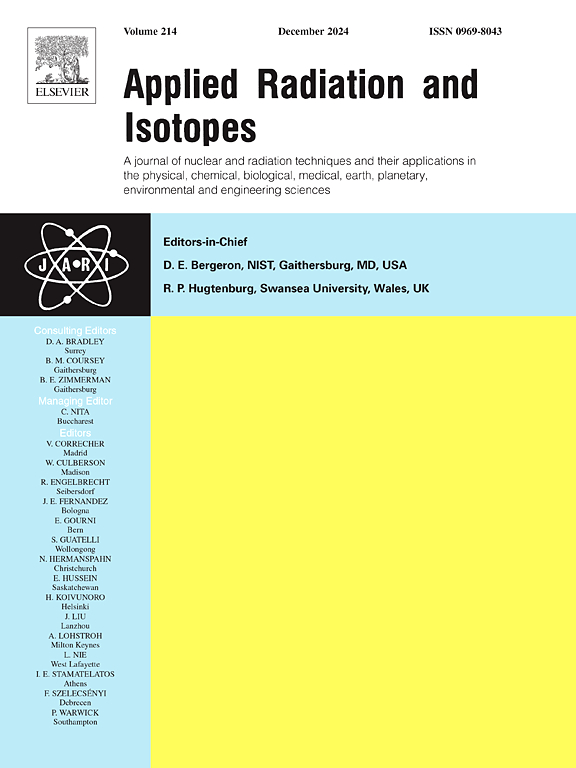评估沙特阿拉伯麦地那儿童和成人核医学程序的辐射剂量并提出 DRL。
IF 1.6
3区 工程技术
Q3 CHEMISTRY, INORGANIC & NUCLEAR
引用次数: 0
摘要
背景:核医学诊断和治疗程序是工作人员和患者电离辐射照射的重要来源。目的:本研究旨在评估沙特阿拉伯麦地那地区两家核医学中心内与常见诊断和治疗程序相关的有效辐射剂量,并提出诊断参考水平(DRLs):从沙特阿拉伯麦地那地区的两家核医学中心收集了 445 名患者的数据。数据根据核医学(NM)程序的类型、给药放射性药物的化学成分以及患者的年龄和体重进行分类。计算了常用 NM 程序的有效辐射剂量,并制定了建议的 DRL:结果:分析了 16 种成人和 2 种儿童核磁共振程序(分为 8 组)的有效辐射剂量。成人核医学诊断程序的有效辐射剂量从 0.05 mSv(Nanocoloid)到 29 mSv(67Ga-柠檬酸盐)不等。儿科手术的有效辐射剂量从 0.80 毫西弗特(5 岁儿童接受肾脏 DTPA)到 1.6 毫西弗特(1 岁儿童接受肾脏 DMSA)不等。此外,还测定了成人和儿童 NM 程序的 DRL 值。研究结果表明,有效辐射剂量与 DRL 值高度一致,与之前发表的研究结果完全吻合:虽然本研究中概述的有效辐射剂量总体上在可接受范围内,且与之前的研究结果一致,但优化辐射剂量仍是当务之急,尤其是在小儿 NM 手术中。本文章由计算机程序翻译,如有差异,请以英文原文为准。
Assessing radiation doses and proposing DRLs for nuclear medicine procedures for pediatric and adult patients in Madinah, Saudi Arabia
Background
Nuclear medicine diagnostic and treatment procedures represent significant sources of ionizing radiation exposure for both staff and patients. Consequently, assessing and optimizing radiation doses are crucial to minimize potential side effects.
Aim
This study seeks to evaluate the effective radiation doses associated with common diagnostic and treatment procedures, as well as propose diagnostic reference levels (DRLs), within two nuclear medicine centers in Madinah, Saudi Arabia.
Methodology
Data from 445 patients were gathered from two nuclear medicine centers in the Madinah region of Saudi Arabia. The data were categorized based on the type of nuclear medicine (NM) procedure, the chemical composition of the administered radiopharmaceutical, as well as patient age and weight. Effective radiation doses for prevalent NM procedures were computed, and suggested DRLs were formulated.
Results
Effective radiation doses were analyzed for 16 adult and 2 pediatric NM procedures (divided into 8 groups). The effective radiation doses for adult diagnostic nuclear medicine procedures range from 0.05 mSv (Nanocoloid) to 29 mSv (67Ga-citrate). For pediatric procedures, the doses range from 0.80 mSv (5-year-old undergoing renal DTPA) to 1.6 mSv (1-year-old undergoing renal DMSA). Furthermore, DRL values were determined for both adult and pediatric NM procedures. The study's findings demonstrated a high degree of concordance between effective radiation doses and DRL values, aligning well with previously published research.
Conclusion
While the effective radiation doses outlined in this study were generally within acceptable limits and consistent with prior research findings, optimizing radiation doses remains imperative, particularly for pediatric NM procedures.
求助全文
通过发布文献求助,成功后即可免费获取论文全文。
去求助
来源期刊

Applied Radiation and Isotopes
工程技术-核科学技术
CiteScore
3.00
自引率
12.50%
发文量
406
审稿时长
13.5 months
期刊介绍:
Applied Radiation and Isotopes provides a high quality medium for the publication of substantial, original and scientific and technological papers on the development and peaceful application of nuclear, radiation and radionuclide techniques in chemistry, physics, biochemistry, biology, medicine, security, engineering and in the earth, planetary and environmental sciences, all including dosimetry. Nuclear techniques are defined in the broadest sense and both experimental and theoretical papers are welcome. They include the development and use of α- and β-particles, X-rays and γ-rays, neutrons and other nuclear particles and radiations from all sources, including radionuclides, synchrotron sources, cyclotrons and reactors and from the natural environment.
The journal aims to publish papers with significance to an international audience, containing substantial novelty and scientific impact. The Editors reserve the rights to reject, with or without external review, papers that do not meet these criteria.
Papers dealing with radiation processing, i.e., where radiation is used to bring about a biological, chemical or physical change in a material, should be directed to our sister journal Radiation Physics and Chemistry.
 求助内容:
求助内容: 应助结果提醒方式:
应助结果提醒方式:


